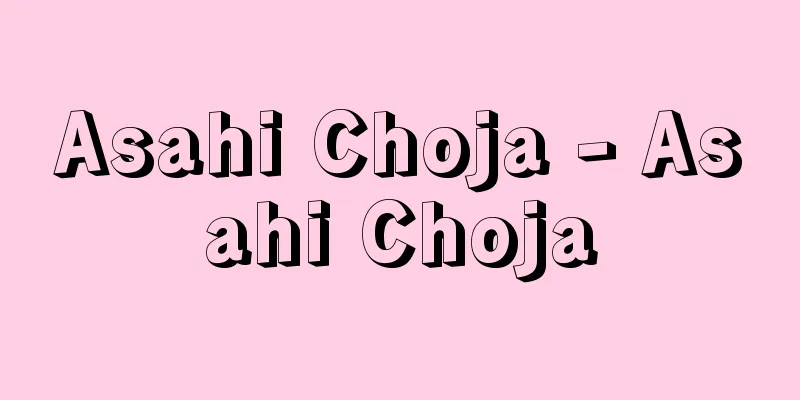Asahi Choja - Asahi Choja

|
One of the Japanese legends about a rich man. It is also called Asahi-Yuhi. It is a legend about a rich man who buried gold at the site of a powerful family's mansion, and most of the legends suggest the location of the treasure with oral folk songs such as "The rising sun shines, and the setting sun shines, under which a thousand golden tiles lie." There are also stories about the rich man being punished by falling into ruin (death) after he was not in time to plant rice in large quantities and used a fan to invite the sun back (for example, Asahi Choja in Kasai City, Hyogo Prefecture, and Koyama Choja in Koyamaike, Tottori City). As well as the fact that many of the names of shrine maidens (miko) include the characters for "sun," "morning sun," and "ten thousand days," this suggests the existence of solar worship in rice-growing rituals. There is also a legend about the good fortune of charcoal burner Kogoro, who entered the mountains uttering the words, "The morning sun is shining...", and in the Kanayago Shinsaimon in the "Iron Mine Necessary Articles" there is a legend about the Asahi Choja appearing and providing financial support for the iron mines, which suggests that the rice-growing rich man controlled the route for charcoal demand and also supplied iron (cast iron).The Harima no Kuni Fudoki, in the section on Kamo County, also has an imperial decree indicating an ideal location, saying, "In a place where the morning sun and the evening sun are not hidden...", indicating the status of the rich man, and this is probably where the name Asahi Choja originated. Additionally, the legend of Mount Kinkei and the Kinkeizuka, which says that a golden rooster could be heard crowing from somewhere because a golden rooster was buried in the mountains or in a mound (for example, Mount Kinkei in Hiraizumi, Iwate Prefecture, which is said to have been buried there by Fujiwara Hidehira), also overlaps with the legend of the rich man, and allows us to infer the cause and effect of wealthy men who saved rice and other grains coming into control of iron. [Shogo Watanabe] Source: Shogakukan Encyclopedia Nipponica About Encyclopedia Nipponica Information | Legend |
|
日本長者伝説の一つ。朝日夕日ともいう。長者、豪族の屋敷跡に黄金を埋めたという伝説で、多くはその財宝のありかを「朝日さし夕日輝くそのもとに黄金千枚瓦(かわら)万枚」などの口承歌謡をもって示唆する類型がほとんど。また長者が大田植の際に時間が足りずに、扇で日を招き返したために、罰があたって没落した(死んだ)というような話を伴っているのもあって(兵庫県加西市の朝日長者、鳥取市湖山(こやま)池の湖山長者など)、巫女(みこ)の名に「朝日」や「照日(てるひ)」「万日(まんにち)」など日のついた名が多いのとともに、稲作儀礼における太陽信仰の伝存を考えさせる。 炭焼長者にも「朝日さす……」のことばを口にして山に入った炭焼小五郎の幸運の伝説があり、『鉄山必要記事』の金屋子神祭文(かなやごしんさいもん)に朝日長者が現れ鉄山経営の資力となった伝承があることから、稲作長者が木炭需要のルートをも握って、鉄(鋳物)の供給も賄った古代の伝承的事実を考えることができる。『播磨国風土記(はりまのくにふどき)』賀毛郡の条にも、理想の場所を示す勅として「朝日夕日の隠(かくろ)はぬ地(ところ)に……」とあるが、長者の地位を示したもので、朝日長者の名の由来もここにあるのだろう。また、山中もしくは塚に金の鶏(にわとり)を埋めたため、そこから金鶏(きんけい)の鳴き声が聞こえるという金鶏山、金鶏塚の伝説(たとえば岩手県平泉町の藤原秀衡(ひでひら)が埋めたと伝える金鶏山)も長者伝説と重なるもので、稲その他の貯穀による富豪の、鉄を支配した因果を推察させてくれる。 [渡邊昭五] 出典 小学館 日本大百科全書(ニッポニカ)日本大百科全書(ニッポニカ)について 情報 | 凡例 |
Recommend
Stations of the Cross
Pilgrims visiting Jerusalem have long worshipped J...
Household - Shotai
{Meaning: something carried on the body} 1. To set...
Route of infection
...Measles can also infect monkeys, but the sympt...
Telloh
…A city in the southernmost part of Mesopotamia, ...
total organized music
...A compositional technique that was widely used...
Arayaji - That's Kadera
Another name for Shitennoji Temple in Tennoji Ward...
editor
...However, while such a system remains in small ...
Chabazite (English spelling)
A type of zeolite characterized by a rhombohedral ...
Alaskan wolf - Alaska wolf
...It seems that this subspecies is the one that ...
Special Exchange Student for the Korean Imperial Family - カンコクコシツトクはりゅうがせ
...Against the backdrop of Japan's growing inf...
Kaifuchu
… [Tadao Yokota] [Kofu Castle Town] A castle town...
Crab-like insect - Crab-like insect
A general term for arthropods belonging to the Cha...
Schönlein - Johann Lukas Schönlein
German physician. Born in Bavaria. Graduated from...
Foreign litigation - Shogaisosho
In the broadest sense, it refers to a lawsuit that...
Farmland Drainage - Uchihaisui
Removing excess water from the surface and ground ...









